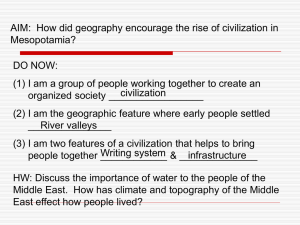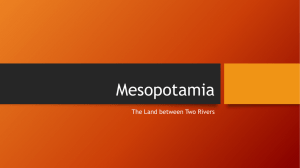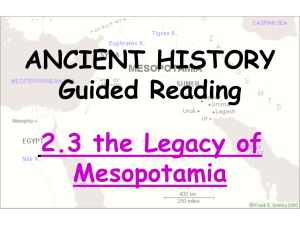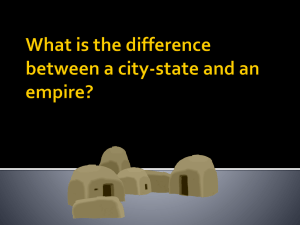Jumaa al-Talabi, Assistant in Baghdad University
advertisement
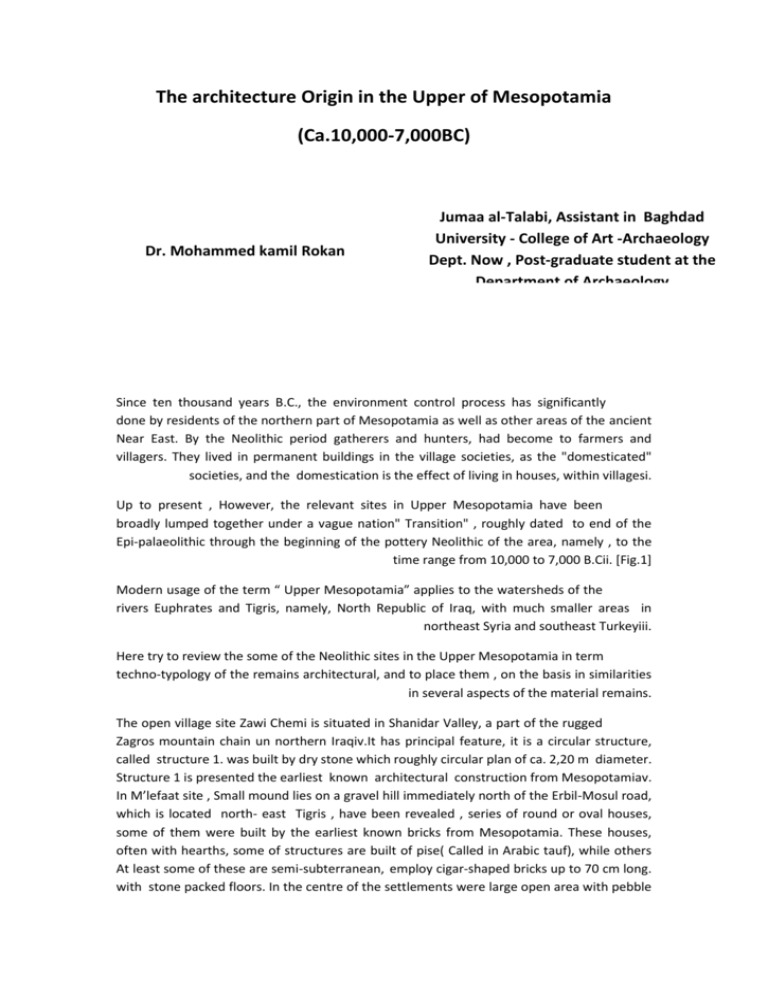
The architecture Origin in the Upper of Mesopotamia (Ca.10,000-7,000BC) Head of Archaeology Dept. Jumaa al-Talabi, Assistant in Baghdad University - College of Art -Archaeology Dept. Now , Post-graduate student at the Department of Archaeology University of Al-Qadissia The Faculty of History Dr. Mohammed kamil Rokan Since ten thousand years B.C., the environment control process has significantly done by residents of the northern part of Mesopotamia as well as other areas of the ancient Near East. By the Neolithic period gatherers and hunters, had become to farmers and villagers. They lived in permanent buildings in the village societies, as the "domesticated" societies, and the domestication is the effect of living in houses, within villagesi. Up to present , However, the relevant sites in Upper Mesopotamia have been broadly lumped together under a vague nation" Transition" , roughly dated to end of the Epi-palaeolithic through the beginning of the pottery Neolithic of the area, namely , to the time range from 10,000 to 7,000 B.Cii. [Fig.1] Modern usage of the term “ Upper Mesopotamia” applies to the watersheds of the rivers Euphrates and Tigris, namely, North Republic of Iraq, with much smaller areas in northeast Syria and southeast Turkeyiii. Here try to review the some of the Neolithic sites in the Upper Mesopotamia in term techno-typology of the remains architectural, and to place them , on the basis in similarities in several aspects of the material remains. The open village site Zawi Chemi is situated in Shanidar Valley, a part of the rugged Zagros mountain chain un northern Iraqiv.It has principal feature, it is a circular structure, called structure 1. was built by dry stone which roughly circular plan of ca. 2,20 m diameter. Structure 1 is presented the earliest known architectural construction from Mesopotamiav. In M’lefaat site , Small mound lies on a gravel hill immediately north of the Erbil-Mosul road, which is located north- east Tigris , have been revealed , series of round or oval houses, some of them were built by the earliest known bricks from Mesopotamia. These houses, often with hearths, some of structures are built of pise( Called in Arabic tauf), while others At least some of these are semi-subterranean, employ cigar-shaped bricks up to 70 cm long. with stone packed floors. In the centre of the settlements were large open area with pebble floors in which grinding stone, mortars and hearths were located, clearly indicating communal use of this area for a range of open-air activitiesvi. In Syrian on the Euphrates, there were two sites have add much information about the occurrence and nature of Communities in this region. The large site is Abu Hureyravii, is located on the right bank of the Euphrates , Has an early occupation of Natufian culture and some features of virgin soil include pits, hearths , post holes and floors, perhaps from semipermanent structures. More substantial evidence for this period has come from Mureybetviii, some 45 km upstream from Abu Hureyra .the Upper Level consists of round semi- subterranean huts of clay with exterior wooden support.[Fig.2] Hallan Cemi Tepesi, in eastern Anatolia, has yielded the remains of small permanent village. The architectural Buildings are circular and semi-subterranean, arranged around an open central area ca.15 m in diameter. Some of contain distinctive features, in the form of a semi-circular stone bench/platform that is set against the wall of each structure. The floors each structure were resurfaced multiple times with a distinctive thin yellow sand and plaster mixture over a layer of relatively sterile dirt fill and were generally devoid of material and objects commonly associated with domestic activitiesix. - Matthews R. The Eaarly prehistory of Mesopotamia 500,000 to 4,500 BC. Oxford,2000,P.31. ii - Ohnuma K . Chronology of the “ proto-Neolithic” of Iraq and Syria _ A Hypothetical view. Al-Rafidan Journal ,Vol. 18,1997.P.45. iii -Matthews R. The Archaeology Mesopotamia, Theories and approaches.london,2003,P.5. i - Solecki R.S. Zawi Chemi Shanidar , A post-Pleistocene Village Site in Northern iv Iraq.Warsaw,1964.P.405. v - Solecki R.S. An Early village site At Zawi Chemi Shanidar. Malibu,1981, P.53. vi -Braidwood, R. Excavations in Iraq Kurdistan . Chicago, 1960.P.27,50./ Dittemore M . The Sounding At M’lefaat . in(ed) Braidwood, R, et.al. Prehistoric Archaeology a long Zagros flanks.(OIP),Vol.105,1983,P.672./Matthews R, 2000,op.cit,P.35. vii - Moore A. M.T . Abu Hureyra and the Beginning of Agriculture and village life on the Euphrates. Subartu Vol. 7, Brepols, Turnhout, Belgium,1998.P.34-35. viii - Cauvin J. The Birth of the Gods and the Origins of Agriculture. Cambridge University press,UK,2003,P.55-59. - Rosenberg M .Hallan Cemi. In(ed)Ozdogan M. Neolithic in Turkey , the cradle of civilization/ new discoveries ,Istanbul,1999,P.25-33./ Peasnall B.L, et.al . Hallan Cemi , Pig husbandry ,and post- Pleistocene adaptations along the Taurus- Zagros Arc ( Turkey). Paleorient , Vol. 24, №.1.1998,P.28. ix


